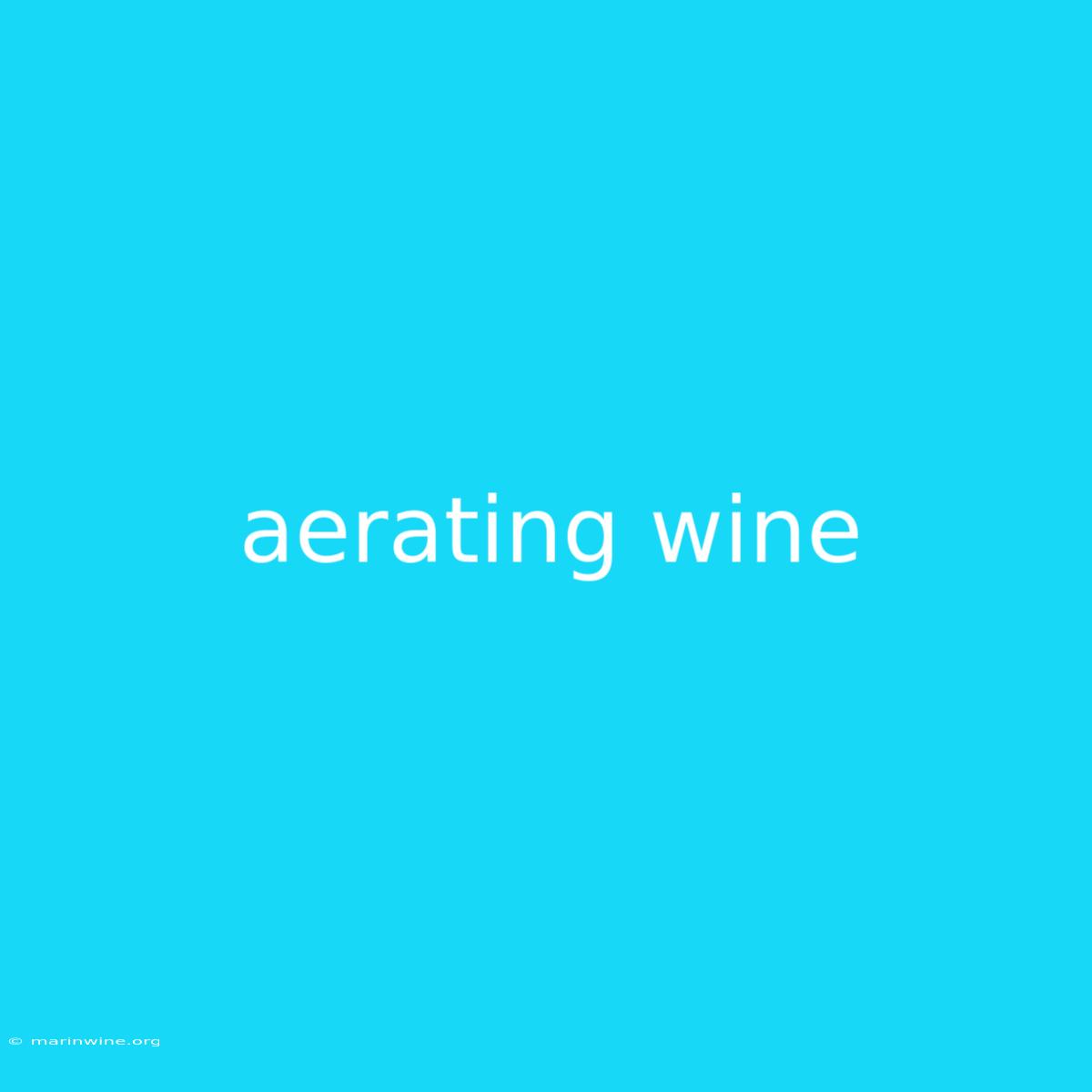Uncorking the Truth: Why Aerating Wine Matters
Have you ever wondered why some wines taste better after they've been open for a while? It's all about aeration! This simple act of exposing wine to oxygen is a crucial part of bringing out its full potential.
Why It Matters: Aerating wine is essential to enhance its flavors and aromas. Think of it as a wine's "warm-up" routine before taking center stage. It allows the complex compounds within the wine to interact with oxygen, resulting in a more nuanced and enjoyable tasting experience.
Key Takeaways of Wine Aeration:
| Key Takeaways | Description |
|---|---|
| Increased Aromas: Aeration releases volatile compounds, allowing aromas to blossom and creating a more complex bouquet. | |
| Softer Tannins: Exposure to oxygen softens harsh tannins, resulting in a smoother and more balanced taste. | |
| Enhanced Flavor Profile: Overall, aeration reveals the wine's true character by allowing delicate flavors to develop and integrate. |
Wine Aeration
Introduction: Wine aeration involves introducing oxygen to the wine, allowing the flavors to open up and the tannins to soften. This can be achieved through various methods.
Key Aspects of Wine Aeration:
- Decanting: This traditional method involves pouring wine from the bottle into a decanter, exposing a larger surface area to oxygen. It's commonly used for older, aged wines or those with high tannins.
- Pouring: Simply pouring wine from one container to another exposes it to oxygen. This is a quick and effective method for everyday drinking.
- Wine Aerator: These tools are designed to rapidly aerate wine by forcing it through a chamber that introduces oxygen. Wine aerators can be handheld or attached to a bottle.
Decanting:
Introduction: Decanting is a time-honored technique that involves transferring wine from the bottle into a decanter. This technique exposes the wine to a larger surface area, allowing it to breathe and develop its full flavor potential.
Facets of Decanting:
- Purpose: Decanting serves to remove sediment from aged wines, improving clarity and enhancing the tasting experience.
- Process: The process involves carefully pouring the wine into the decanter, leaving the sediment behind in the bottle.
- Time: Depending on the wine's age and tannin levels, decanting can take anywhere from 30 minutes to several hours.
Summary: Decanting is a valuable technique for enhancing the flavor and aromas of older wines, particularly those with significant sediment.
Wine Aerator:
Introduction: Wine aerators are innovative tools designed to expedite the aeration process. They utilize various methods, such as a spout or chamber, to introduce oxygen into the wine as it is poured.
Further Analysis:
- Types: Handheld aerators are portable and easy to use, while bottle-mounted aerators are more convenient for everyday use.
- Benefits: Wine aerators provide quick and effective aeration, enhancing the wine's flavor and aromas within minutes.
- Considerations: While effective, wine aerators can affect the wine's temperature, so it's best to use them after chilling the wine.
Closing: Wine aerators offer a practical solution for enjoying the benefits of aeration without the need for extensive decanting time.
Information Table:
| Method | Description | Time | Best for |
|---|---|---|---|
| Decanting | Pouring wine into a decanter | 30 minutes to several hours | Older wines, high tannin wines |
| Pouring | Transferring wine from bottle to glass | 10 minutes | Everyday wines |
| Wine Aerator | Using a tool to introduce oxygen | 1-5 minutes | Quick aeration, enhancing aromas |
FAQ for Wine Aeration:
Introduction: This section answers some common questions about wine aeration.
Questions:
- Do all wines need aeration? While not all wines require aeration, most benefit from it to some degree.
- How long should I aerate wine? The optimal aeration time varies based on the wine's age, grape variety, and tannin level.
- Is it okay to over-aerate wine? Over-aeration can lead to oxidation, causing the wine to become dull and lifeless.
- What if I don't have a decanter? You can use a pitcher, a tall glass, or even pour the wine back and forth between two glasses.
- Are wine aerators worth the cost? Wine aerators are a convenient and effective way to enjoy the benefits of aeration.
- Can I aerate red wine only? While red wines generally benefit more from aeration, white and rosé wines can also be aerated to improve their complexity.
Summary: Wine aeration is a simple yet effective technique for enhancing the flavor and aroma of wine. While not all wines require aeration, it's a valuable tool for appreciating a wide range of wines.
Tips for Wine Aeration:
Introduction: These tips can help you achieve optimal aeration and enhance your wine-tasting experience.
Tips:
- Consider the wine's age and style. Older wines and those with high tannins benefit most from aeration.
- Use the right tool. Choose a decanter, pourer, or wine aerator that suits your wine and your preference.
- Start with a small pour. Allow the wine to breathe for a few minutes before filling the glass.
- Don't over-aerate. Too much oxygen can make the wine taste flat and oxidized.
- Experiment! Different wines react differently to aeration. Try different methods and discover what works best for you.
Summary: With a little practice and experimentation, you can unlock the full potential of your wine and enjoy its flavors to the fullest.
Summary by Wine Aeration:
Summary: Wine aeration is a vital process that unlocks a wine's true character. From decanting to using wine aerators, several techniques can be employed to expose wine to oxygen, leading to a more complex bouquet, softened tannins, and enhanced flavors.
Closing Message: Whether you are a seasoned oenophile or just beginning to explore the world of wine, embracing aeration can elevate your wine-tasting experience to new heights.

